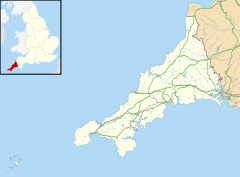
Newquay is a town on the north coast in Cornwall, England, United Kingdom. It is a civil parish, seaside resort, regional centre for aerospace industries with an airport and a spaceport, and a fishing port on the North Atlantic coast of Cornwall, approximately 12 miles (19 km) north of Truro and 20 miles (32 km) west of Bodmin.

Fistral Beach is in Fistral Bay on the north coast of Cornwall, England, United Kingdom. It is situated half a mile west of Newquay at grid reference SW 797 620.

Rock is a coastal fishing village in Cornwall, England, United Kingdom. It is opposite Padstow on the north-east bank of the River Camel estuary. The village is in the civil parish of St Minver Lowlands about 4 miles (6.4 km) north-west of Wadebridge.
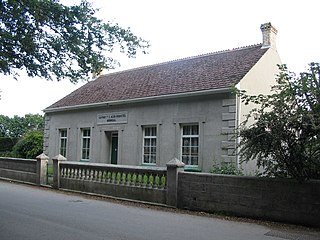
Luxulyan, also spelt Luxullian or Luxulian, is a village and civil parish in mid Cornwall, England, United Kingdom. The village lies four miles (6.5 km) northeast of St Austell and six miles (10 km) south of Bodmin. The population of the parish was 1,371 in the 2001 census. This had risen to 1,381 at the 2011 census.

Porthtowan is a small village in Cornwall, England, UK, which is a popular summer tourist destination. Porthtowan is on Cornwall's north Atlantic coast about 2 km (1.2 mi) west of St Agnes, 4 km (2.5 mi) north of Redruth, 10 km (6.2 mi) west of Truro and 15 km (9.3 mi) southwest of Newquay in the Cornwall and West Devon Mining Landscape, a World Heritage Site.

St Columb Minor is a village in the civil parish of Newquay, on the north coast of Cornwall, England, United Kingdom.
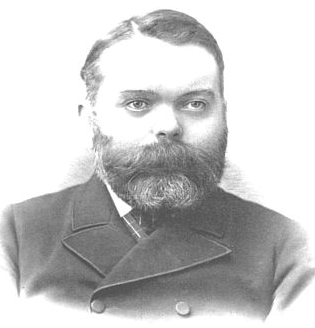
Silvanus Trevail was a British architect, and the most prominent Cornish architect of the 19th century.

St Mewan is a civil parish and village in south Cornwall, England, United Kingdom.

Lelant or Uny Lelant is a village in the civil parish of St Ives in, west Cornwall, England, UK. It is on the west side of the Hayle Estuary, about 2+1⁄2 miles (4.0 km) southeast of St Ives and one mile (1.6 km) west of Hayle. The village is part of the Lelant and Carbis Bay ward on Cornwall Council, and also the St Ives Parliamentary constituency. The birth, marriage, and death registration district is Penzance. Its population at the 2011 census was 3,892 The South West Coast Path, which follows the coast of south west England from Somerset to Dorset passes through Lelant, along the estuary and above Porth Kidney Sands.

Porth is a seaside hamlet in the civil parish of Newquay, Cornwall, England.
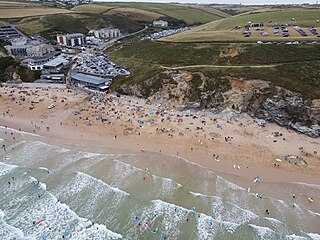
Watergate Bay is a long bay or beach flanked by cliffs centred two miles NNE of Newquay below the B3276 Newquay to Padstow road near the hamlet of Tregurrian in Cornwall, United Kingdom. It faces the Atlantic Ocean, adjacent to Newquay Bay. The 2-mile (3.2 km) sandy beach and exposed site is popular for non-powered water sports, kite flying, and sand art.
The Cribbar, also known as the Widow Maker, is a reef off the Towan Headland in Newquay, Cornwall, England, United Kingdom.
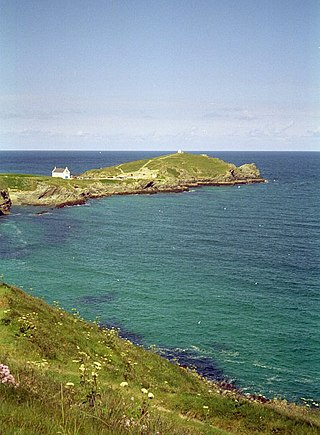
Towan Head is a headland one mile west of Newquay on the north coast of Cornwall, England, United Kingdom. It is at the western end of Newquay Bay. The headland points north and Fistral Beach is immediately to the south.
Trethurgy is a village in the parish of Treverbyn, Cornwall, England, United Kingdom. It is about two miles northeast of St Austell. Carne Farm, Trethurgy is the birthplace of Silvanus Trevail, a president of the Society of Architects and the architect of many well known Cornish hotels such as the Headland Hotel, Newquay and the Carbis Bay Hotel, Carbis Bay.
The Atlantic coast of Cornwall normally referred to locally as the North Coast, due to its north-facing orientation, makes up approximately half the coastline of Cornwall. Part of the South West Coast Path runs its entire length. It is known for its beaches, some of which are regarded by many to have the best surf in Europe. Fistral Beach has hosted the World Surfing Championships and hosts various other national and relevant surfing events every year.
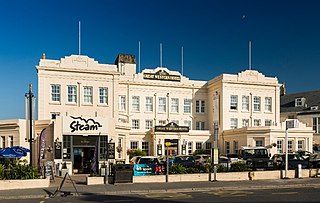
The Great Western Hotel is the oldest purpose-built hotel in Newquay, Cornwall. The hotel was originally designed by the Cornish architect Silvanus Trevail and first opened in April 1879. The hotel is built in a prominent position overlooking Great Western Beach.

The Hotel Victoria is in Newquay, Cornwall, United Kingdom and is near the cliffs above the Great Western Beach. The Hotel first opened in June 1899.
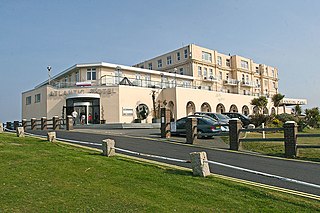
The Atlantic Hotel is in Newquay, Cornwall, United Kingdom. It was first opened in July 1892 and occupies a prominent position on the shore, with views of the Atlantic Ocean & the North Cornish coast.
The Glendorgal Hotel is in Newquay, Cornwall overlooking Porth Beach.

Newquay Central is an electoral division of Cornwall in the United Kingdom and returns one member to sit on Cornwall Council. The current Councillor is Geoff Brown, a Liberal Democrat and the Portfolio Holder for Transport on the council.

